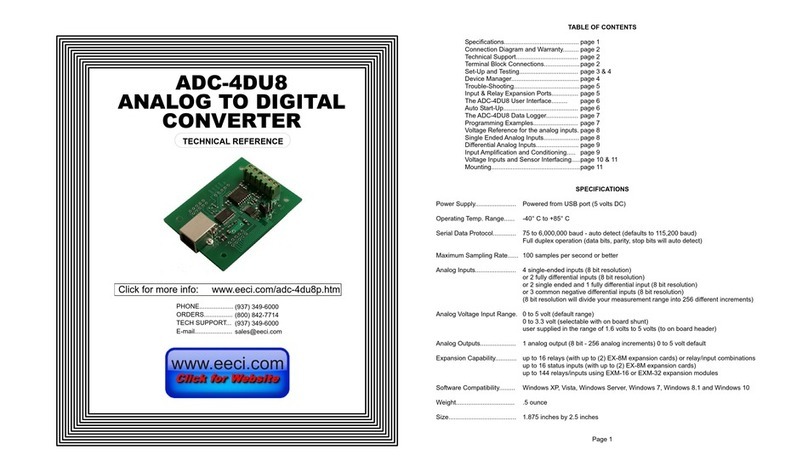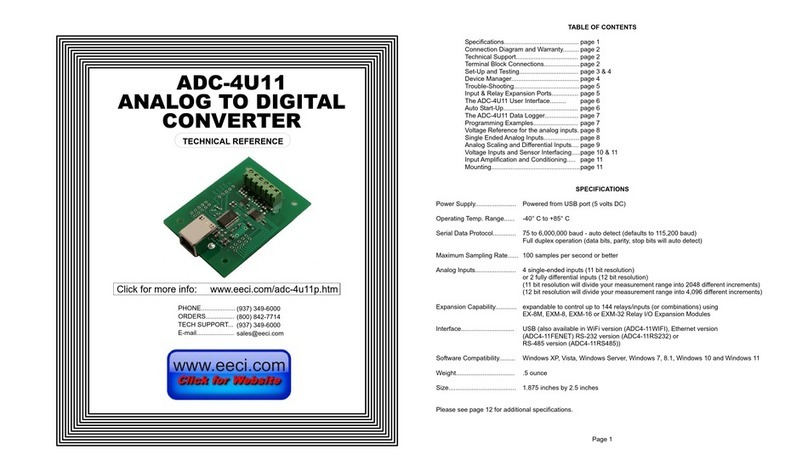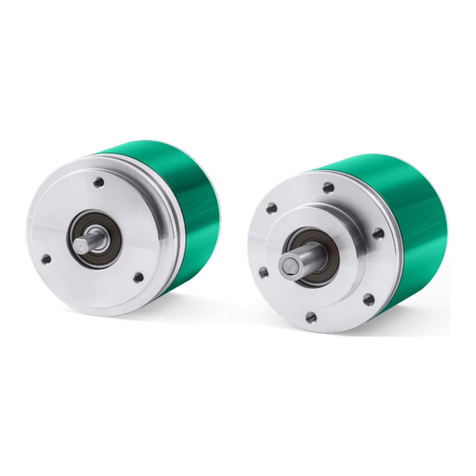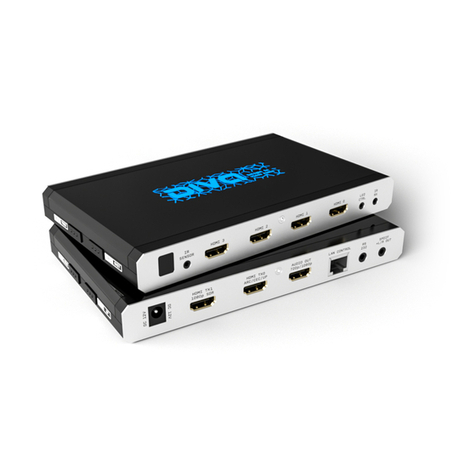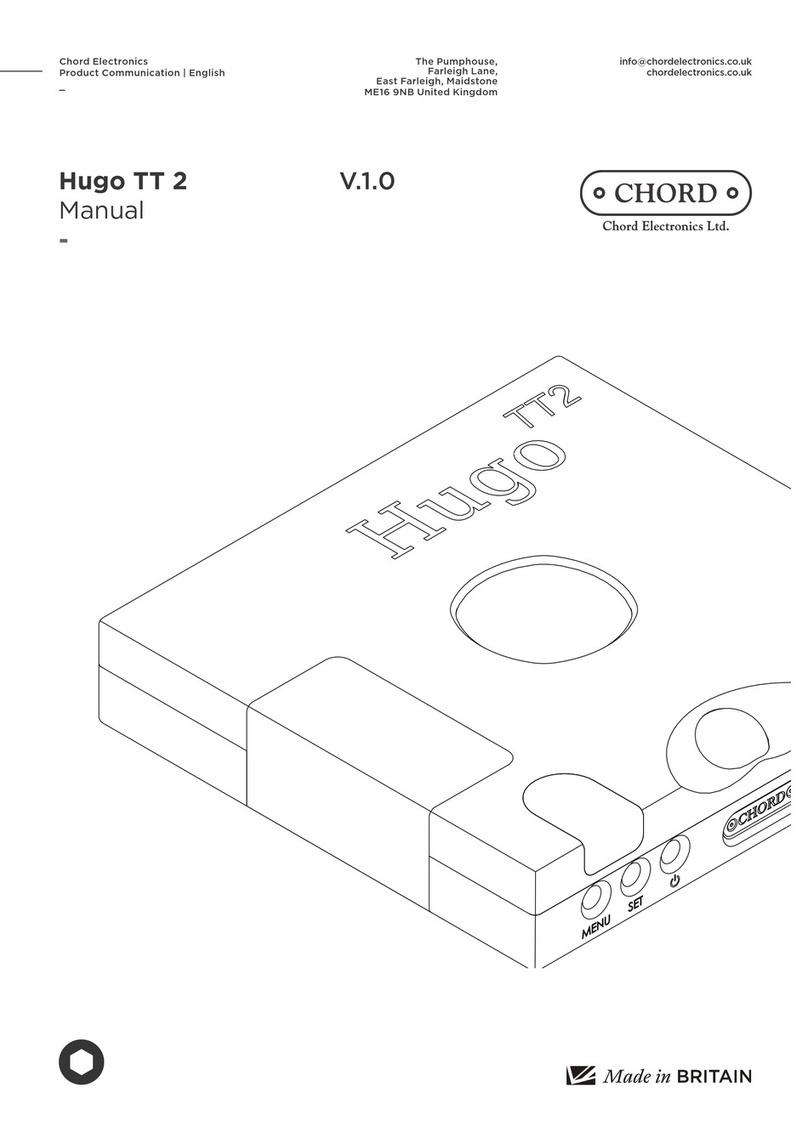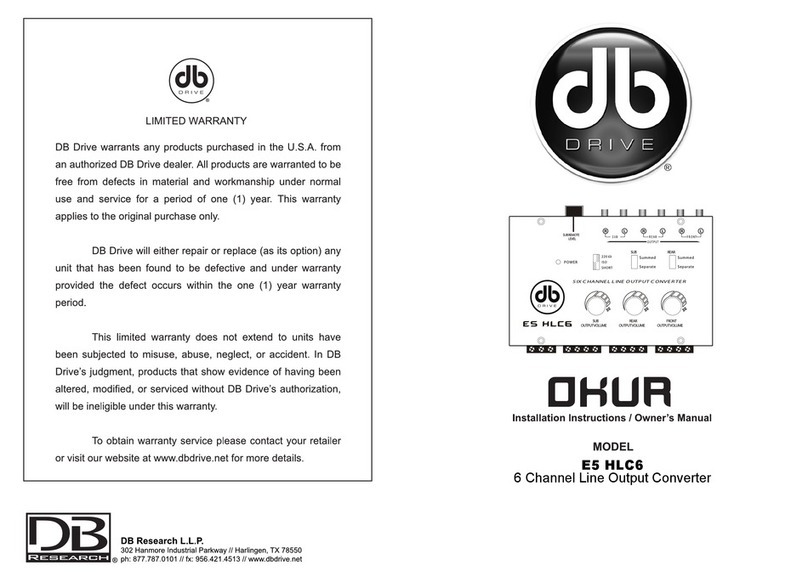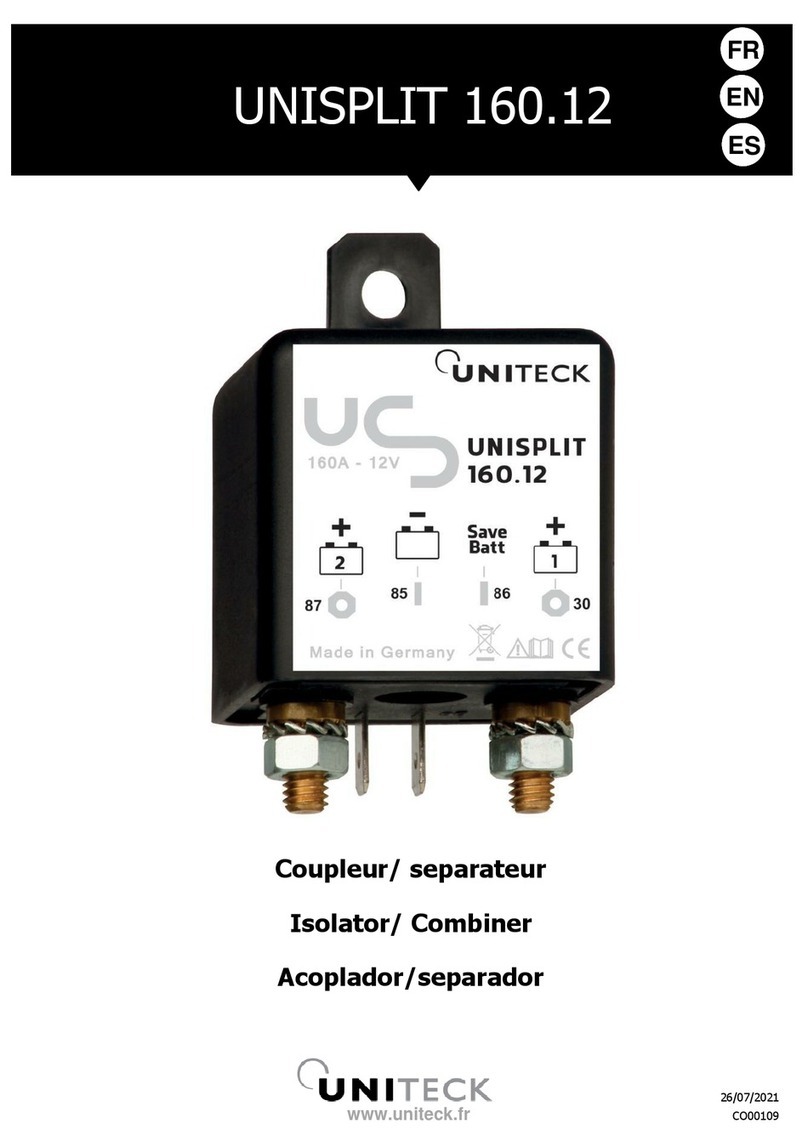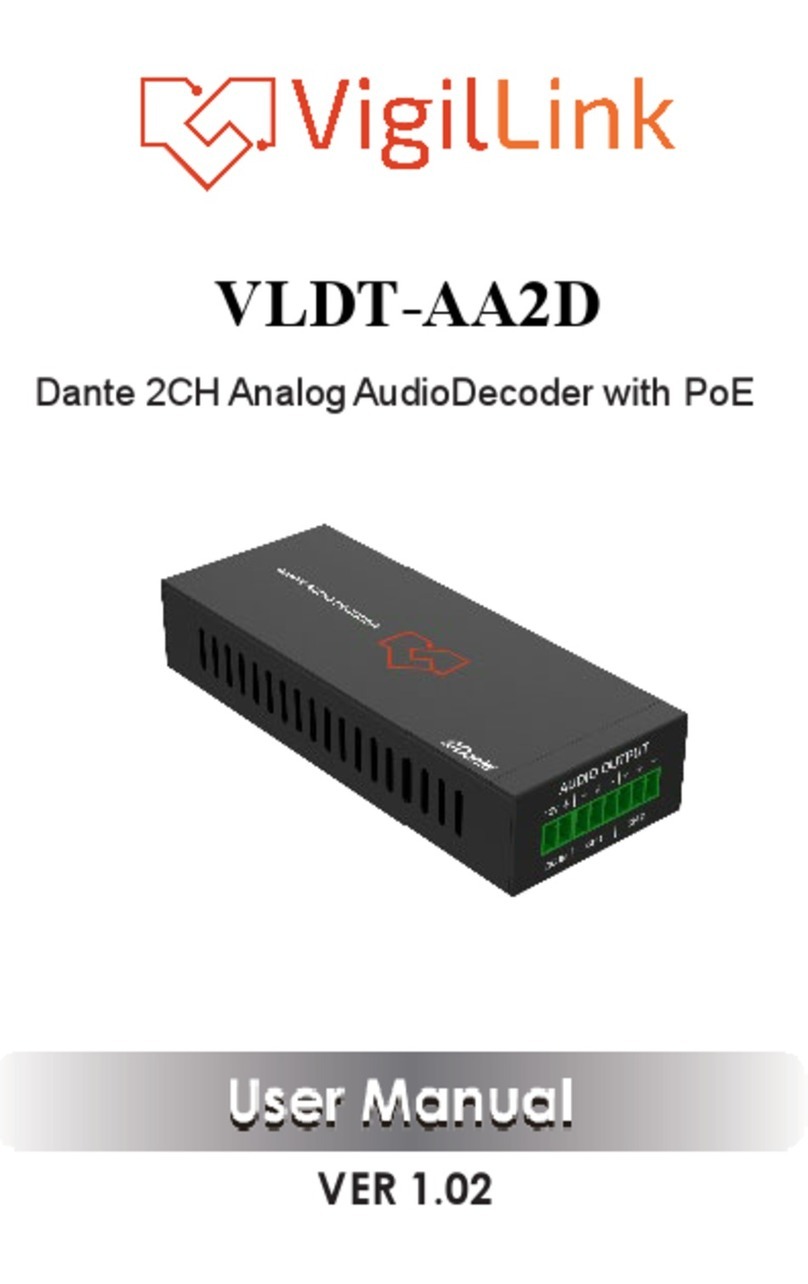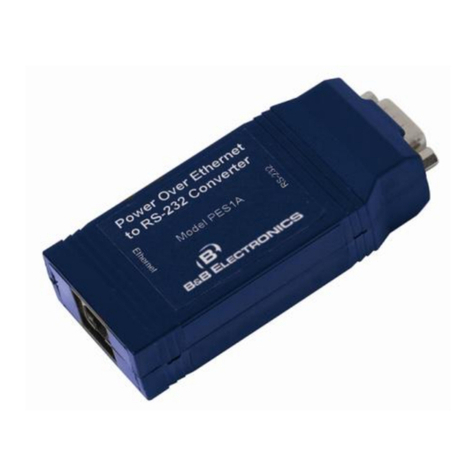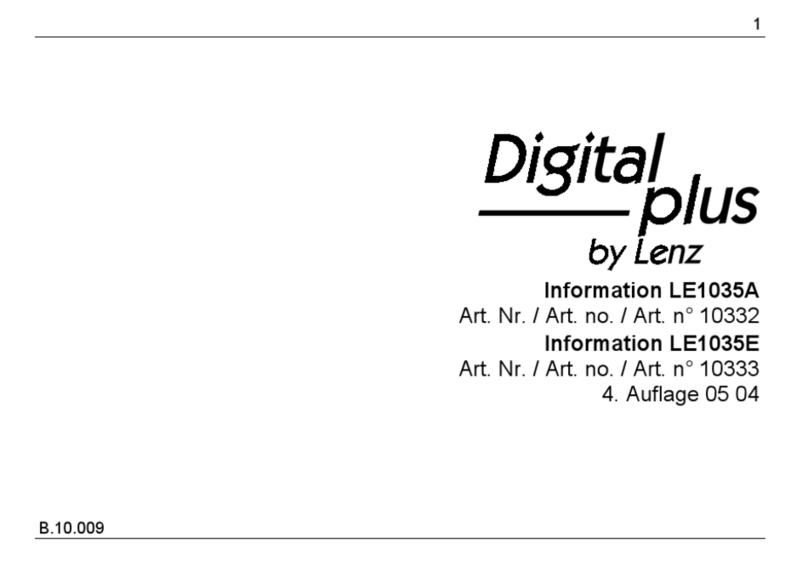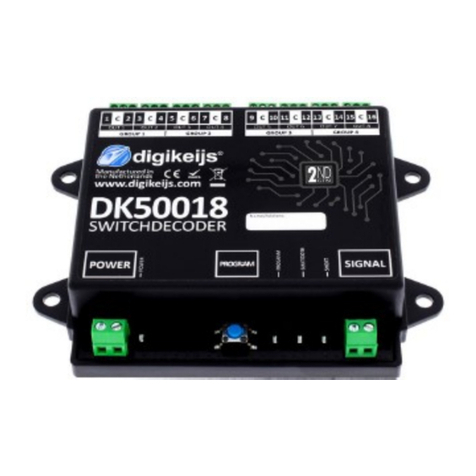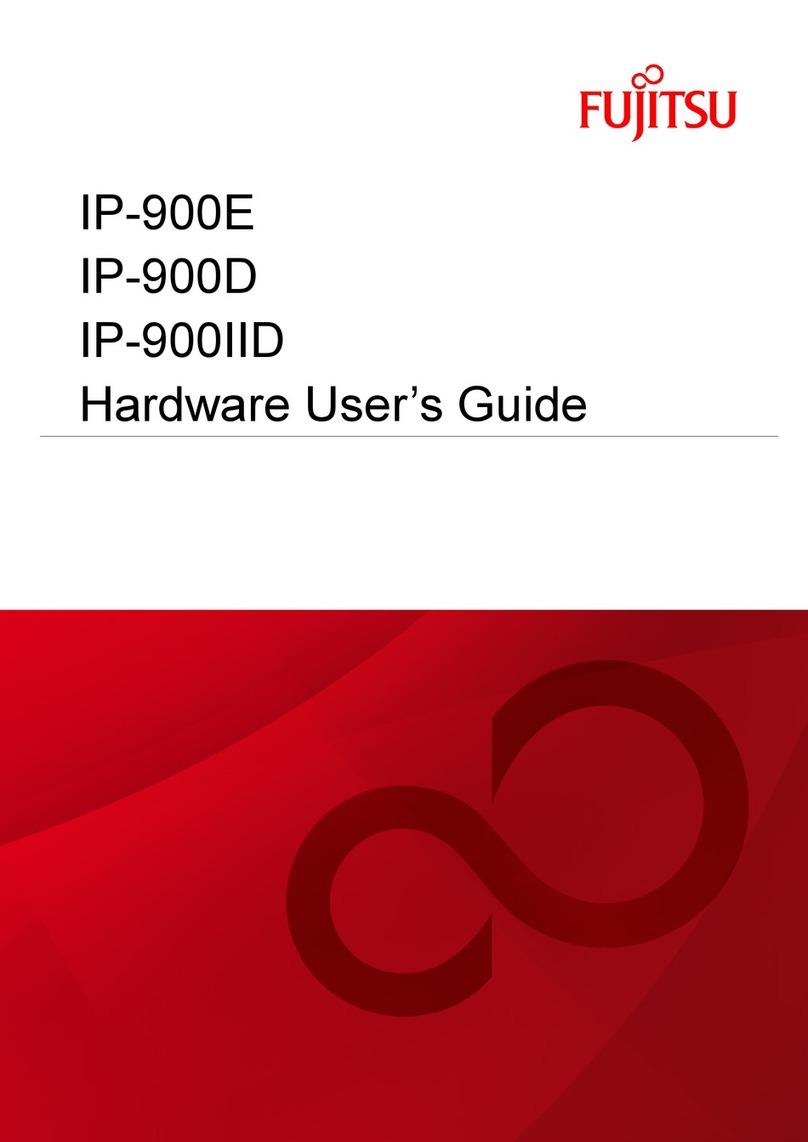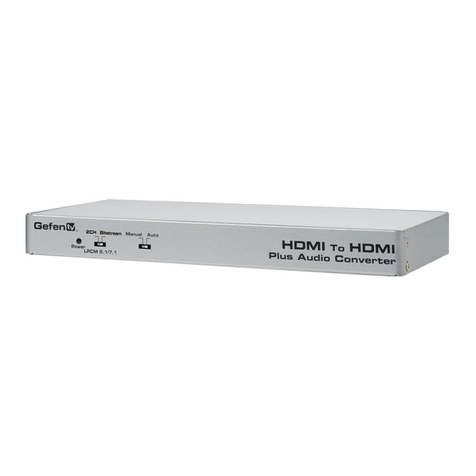EECI ADC-4 Use and care manual

TABLE OF CONTENTS
Specifications, Technical Support and Warranty.... page 1
Connection Diagram.............................................. page 2
Power Supply Requirements.................................. pages 2, 3 & 8
Set-Up and Testing................................................ page 3
Connector Pin-Outs............................................... pages 4 & 5
Analog Input Connections & Trouble Shooting...... page 5
Expansion Ports.................................................... page 6
Adding Analog and Status Inputs........................... page 7
Baud Rate/Protocol Selection................................ page 7
Voltage Input Amplification & Signal Conditioning.. page 8
RS-422 and RS-485 Interfacing............................ page 9
Calibration and Trimpot Adjustment...................... pages 9 & 10
Commercial Use of the ADC-4.............................. page 10
12 Bit Analog Inputs............................................... page 10
8 Bit Analog Inputs................................................. page 11
10 Bit Analog Inputs & Analog Input Interfacing..... pages 12 & 13
Control Software.................................................... pages 13, 14 & 15
Rack Mounting and Repair Service........................ page 16
SPECIFICATIONS
Power Supply....................... 9 to 14 volts DC (300MA)
Protocol for Serial Data I/O.. 50 to 19,200 baud (defaults to 8 data bits, no parity & 1 or 2 stop bits)
(sampling at a maximum of 850 samples per second single channel)
Resolution.......................... 4 channels at 12 bit (providing 4,096 increments per channel)
8 channels at 8 or 10 bit with optional port #2 (256 or 1,024 increments)
Input Channels................... 4 analog channels (12 analog channels with optional port #2)
Expansion Capability.......... up to (112) relays (using EX-16 Relay Expansion cards)
up to (128) status inputs (using ST-32 Status Expansion cards) or...
up to (24) additional 8 or 10 bit analog inputs (using AD-16 Analog Expansion)
up to (24) temperature inputs (using the /E and /F Temperature Input options)
Software Compatibility......... All Windows operating systems, DOS and most other operating systems.
Hardware Compatibility....... Typically this will be all computers that support serial communications, from
the slowest 8086 to the fastest Quad core and newer.
Weight................................ 6 ounces
Size.................................... 7 inches by 5 inches
TECHNICAL SUPPORT
Technical support for our products is available by calling (937) 349-6000. If a technical adviser is not available, please
leave your name, phone number and a time that you can be reached. Your call will be returned as soon as possible
and within 8 hours.
WARRANTY AND CARE OF THE ADC-4
The ADC-4 Analog to Digital Converter is warranted against factory defects for a period of 90 days from the date of
purchase. The ADC-4 has proven to be extremely reliable in actual operation during field tests. We recommend that
Page 1
TECHNICAL REFERENCE
ADC-4
ANALOG TO DIGITAL
CONVERTER
Click for more info: www.eeci.com/adc-4p.htm
(937) 349-6000
(800) 842-7714
(937) 349-6000
PHONE...................
ORDERS................
TECH SUPPORT...
E-mail.....................
www.eeci.com

POWER SUPPLY FUSING: A 500 milliamp (.5 amp) in-line fuse should be installed in series with the (+) power supply
lead to protect the power supply and the ADC-4 from damage (or order with the /T option).
SET UP AND TESTING
PLEASE TEST ALL YOUR HARDWARE FOR PROPER OPERATION UPON RECEIVING YOUR ORDER
(1) Connect the serial cable to COM1 of your computer and connect the other end to the ADC-4 as shown page 2. If
you did not order a serial cable with your ADC-4, you may construct your own as shown on page 4. Connect the
PS-GP-1 power supply to the (+) and (-) terminals on the ADC-4 terminal block and plug the power supply into a
120 VAC power source. Use caution not to set the ADC-4 card on a metal surface or the ADC-4 may be damaged.
Connect a DB-9 socket with 6 wires attached to analog input port #1 (if port # 2 is installed, connect an RCT-8 terminal
block). The ADC-4 is factory set for 19,200 baud which is the proper setting for use with the test software which is
provided on CD.
(2) If your operating systems is Windows 95, 98, ME, or Windows 2000 you must use the Universal App on the
installation CD for testing your ADC-4. Windows XP, Vista, Windows 7, Windows 8 and up users may install the .Net
App* which uses the Microsoft .Net Framework. Click the install App button on the installation CD startup window or
run setup.exe in the folder Windows Data Acquisition Program. If prompted about an older file, keep your newer file.
Once installed, run the ADC-16 program. The program defaults to Com 1. Other Com ports may be selected if
required.
*Please note that the Microsoft .Net Framework must be installed on your system. If the .Net Framework is not installed
on your computer, the ADC-4 installation program will attempt to download and install the .Net Framework from the
Microsoft web site through your internet connection. This may take 5 minutes or longer. In order for the .Net
Framework to install correctly, your computer must be up to date with Windows update (Windows XP must have
service pack 3 installed). This is especially important with Windows XP and Vista. You may update your computer by
clicking on the start button, All Programs, Windows Update and clicking on "Check for Updates".
Your screen will show a row of 4 numbers. The top 4 numbers represent the analog inputs for port #1 (12 bit in 4,096
increments) and the bottom 8 numbers represent the analog inputs for port #2 (8 or 10 bit, 256 or 1,024 increments if
installed). The numbers may be fluctuating as a result of noise on the analog inputs (this is normal). If the 12 bit analog
inputs do not appear to be functional, reset the ADC-4 by removing power briefly (see below).
(3) Test each analog input by connecting each input (one at a time) to the reference (-) terminal on the DB-9 or RCT-8
(see page 5). Your screen should show a "0" for that input. After this is completed, connect each input (one at a time)
to the reference (+). Your screen should show a "4095" for the 12 bit inputs, "1023" for 10 bit inputs or "255" for 8 bit
inputs. If additional testing is desired, use a 20 turn 10K trimpot with the top terminal connected to reference (+), the
bottom terminal connected to reference (-) and the middle (slider) terminal connected to the analog input. The input
shown on the screen should increment from "0 to 4095" for 12 bit inputs, from "0 to 1023" for 10 bit inputs and from "0
to 255" for 8 bit inputs. The number on each input should increment by one as the trimpot is adjusted from 0 to 20
turns.
(4) If operation of the analog inputs are normal then testing is now complete and your ADC-4 may
be placed in service. If problems are encountered during testing, proceed to page 5 for trouble-shooting procedures.
ADC-4 POWER-UP
Caution must be taken when suppling power to the ADC-4. The 12 bit converter has an on-chip microprocessor
which is sensitive to power supply noise and low voltage power-up. The on-chip microprocessor may not "boot"
properly if the power supply is noisy or if power is supplied too slowly. If the microprocessor does not "boot" properly,
the 12 bit inputs may not function or may behave erratically. If you experience difficulty with the 12 bit inputs of the
ADC-4 as a result of the microprocessor not booting properly, connect your power source as shown on the following
page. The 2200 mf capacitor must be placed before the switch and fully charged before power is supplied to the ADC-
4. Close the switch to power the ADC-4 and boot the 12 bit microprocessor.
Page 3
the ADC-4 and associated hardware be installed in a suitable enclosure (4 mounting holes are provided on the circuit
board) and that reasonable precautions be taken to protect the circuit from static discharge. The most likely damage
to occur is that caused by lightning discharge through the power supply or serial I/O lines. The best way to prevent
this type of damage is to install a Power Protector (Part # SP-120 or Surgebuster #120K15A) in the electrical outlet
which supplies power to the hardware. Shielding the analog input lines will provide additional protection. If further
protection is desired, install a TransZorb across the power input to the interface card (part #SP-12K) or you may add
the /T option when ordering.
CONNECTION DIAGRAM
A D C - 4 A N A L O G T O
D I G I T A L C O N V E R T E R
POWER SUPPLY REQUIREMENTS
The ADC-4 may be powered from any DC voltage source which will supply 300 ma within a voltage range of 9 to 14
volts. The recommend power supply for use with a single ADC-4 card is the PS-GP-1 (wall transformer supply). Use
caution when connecting the power source, reversed polarity may cause damage.
The heat dissipation of the 7805 regulator on the ADC-4 will be greatly reduced with a 9 volt power source. The PS-
9VDC-500 and PS-9VDC-1000 wall transformer power supplies may be used to power both the ADC-4 and
expansion card(s). If 12 volt adapters are used, the 7812 regulator which is suppled with the power supply should be
used to regulate voltage to the hardware (as shown on page 8). The PS-12VDC-500 and PS-12VDC-1000 are
unregulated supplies and may produce voltages as high as 18 volts.
The 12 bit converter is sensitive to power supply noise and slow power-up (as a result of the on- chip
microprocessor). See the section on the following page on ADC-4 power-up.
Page 2
RELAY EXPANSION PORT
connect up to (7) EX-16
expansion cards to control
up to 112 relays
T R S - - +
ADC-4 TERMINAL BLOCK CONNECTIONS
RS-232 Transmitter ( connect to green wire)
RS-232 Receiver (connect to white wire)
(+) 12 volt control signal for use with RS-232 (connect to black wire)
RS-232 signal ground (connect to red wire)
Power supply (black wire) (use caution, reversed polarity may
Power supply (red wire) cause damage, 9 to 14 volts DC only)
(T)
(R)
(S)
(-)
(-)
(+)
ALL RIBBON CABLES MUST
BE INSTALLED WITH THE
KEY NOTCH POINTING
UP (red conductor should be
positioned as shown, see
illustration on page 16)
INPUT EXPANSION PORT
connect up to (4) ST-32
status expansion cards for
an additional (128) status
inputs or (1) AD-16 analog
expansion card for (16 )
additional analog inputs
ANALOG INPUT PORT #1
to connect inputs 1 thru 4
(12 bit)
ANALOG INPUT PORT #2
to connect inputs 5 thru 12
(8 or 10 bit if installed)
J4
J3
10K
RED
RED
RED

ADDITIONAL CONNECTOR PIN-OUTS
5 PIN DIN 8 PIN MINI-DIN RS-422
(Apple) (Mac & IBM) (DB-9 plug)
Pin # Connection Pin # Connection Pin # Connection
(1) DTR (1) DTR (2) Transmitter (+)
(2) Signal Ground (2) DSR, DCD & CTS (3) Equipment Ground
(3) DSR (3) Transmitted Data (4) Receiver (+)
(4) Transmitted Data (4) Signal Ground (7) Transmitter (-)
(5) Received Data (5) Received Data (8) Receiver (-)
NOTE: The above connector illustrations are viewed from the rear (solder side).
RCT-8 TERMINAL BLOCK CONNECTIONS (8 & 10 BIT) 12 BIT DB-9 CONNECTIONS
TROUBLE SHOOTING THE ADC-4
(1) Verify power to the ADC-4 by checking for a minimum of 9 volts DC at the terminal block and for 5 volts DC on the
2200 mf capacitor located above the terminal block (low voltage may indicate an overload). Also check for the correct
polarity of the power. Verify that the ADC-4 is set to the same baud rate as what appears on the test software screen.
(2) Check the Com Port used with the ADC-4. Open device manager by clicking on the "Open Device Manager"
button on your installation CD (or by going to control panel). Click the small triangle (or +) to the left of Ports to
expand the Ports category, right click on the Com port that you have the ADC-4 connected to and click properties.
Check the Com port status and verify that you have the test program set to this Com port and verify that you have the
ADC-4 connected to this Com port.
If you are connecting the ADC-4 to a USB port, the Com port entry must be "Prolific USB to Serial Comm Port".
Right click on this entry, click properties and open the Driver tab. Your USB Com driver must be Prolific version
Page 5
RCT-8
Analog Input #1
Analog Input #2
Analog Input #3
Analog Input #4
Analog Input #5
Analog Input #6
Analog Input #7
Analog Input #8
(+ Reference)
(- Reference)
Red Line
Ribbon Cable to
ADC-4
NOTE: The RCT-16 will
have the same connections
as two RCT-8
(1) Analog Input #1
(2) Analog Input #2
(3) Analog Input #3
(4) Analog Input #4
(5) Reference (+)
Reference (-) (6)
Calibrate* (7)
5 V Digital Power (8)
Shield Ground (9)
DB-9 SOCKET (female)
viewed from solder side (rear)
*see page 9
(5)
(3)
(2)
(4)
(1)
(6)
(7)
(8)
(9)
(1)
(2)
(3)
(4)
(5)
ARROW
(2)
(1)
(3)
(4)
(5)
CONNECTOR PIN-OUTS
DB-9 CONNECTOR...SOCKET (female)
(rear view/solder side) DB-25 CONNECTOR...SOCKET (female)
(rear view/solder side)
DB-9 Pins Connection
DB-25 Pins Connection
(1) Data Carrier Detect* (connect to black
wire or terminal (S) on the ADC-4) (2) Transmitted Data (connect to white wire
NOTE: This connection is not needed on or terminal (R) on the ADC-4)
most computers.
(3) Received Data (connect to green wire
(2) Received Data (connect to green wire or terminal (T) on the ADC-4)
or terminal (T) on the ADC-4)
(7) Signal Ground (connect to red wire or
(3) Transmitted Data (connect to white wire terminal (-) on the ADC-4)
or terminal (R) on the ADC-4)
(8) Data Carrier Detect* (connect to black
(5) Signal Ground (connect to red wire or wire or terminal (S) on the ADC-4)
terminal (-) on the ADC-4) NOTE: This connection is not needed on
most computers.
The following pins are optional and may be used
as needed for specific applications. The following pins are optional and may be
used as needed for specific applications.
(4) Data Terminal Ready (DTR) output from
your PC. (4) Request to Send (RTS) output from your PC.
(6) Data Set Ready (DSR) input to your PC. (5) Clear to Send (CTS) input to your PC.
(7) Request To Send (RTS) output from your PC. (6) Data Set Ready (DSR) input to your PC.
(8) Clear To Send (CTS) input to your PC. (20) Data Terminal Ready (DTR) output from your PC.
Page 4
(20) Data Terminal Ready
(1) Data Carrier Detect
(2) Received Data
(3) Transmitted Data
(4) Data Terminal Ready
(5) Signal Ground
(6) Data Set Ready
(7) Request to Send
(8) Clear to Send
(1) Equipment Ground
(2) Transmitted Data
(3) Received Data
(4) Request to Send
(5) Clear to Send
(6) Data Set Ready
(7) Signal Ground
(8) Data Carrier Detect

ADDING ADDITIONAL INPUTS
The Input Expansion Port allows up to (128) additional status inputs or (16) additional analog inputs to be connected
(using up to (4) ST-32 status expansion cards or (1) AD-16 analog expansion card). Each ST-32 expansion card will
provide an additional 32 status inputs. The first ST-32 card connects to the input expansion port on the ADC-4.
Additional ST-32 cards connect to the preceding ST-32 card. One AD-16 analog expansion card can be connected to
the ADC-4 in place of the ST-32 expansion cards to provide an additional 16 analog inputs. If more than 32 analog
inputs are required, contact technical support for customized hardware. The software channel codes for the AD-16
analog inputs are 16 to 31. The additional analog inputs are identical to those described on pages 10, 11 & 12 for the
ADC-4 and the software is handled in the same manner with the exception of the channel codes. The status inputs
are read by transmitting a single byte status port code to the ADC-4. Transmitting a 16 would request information for
the first 8 status inputs on the ST-32 status expansion card. The ADC-4 would then transmit a single byte number
(each bit representing one status input). Additional information is provided with the ST-32 status expansion card.
For applications requiring more than 32 analog inputs/128 status inputs or applications requiring more than 112
relays, the PS-4 or PS-8 port selector may be used as a bank selector to select one bank of 32 analog inputs/128
status inputs and 112 relays. In this manner, up to 4,096 analog inputs or up to 16,384 status inputs may be
connected and 14,336 relays may be controlled (128 banks times 112 relays and 128 status inputs or 32 analog
inputs). An example of this method is shown on page 9 using four banks to provide 128 analog inputs and control of
448 relays.
BAUD RATE SELECTION FOR THE ADC-4
Select the desired baud rate by placing the removable shunts in the positions which correspond to the desired baud
rate. All four of the shunts must be in place for the ADC-4 to operate properly. The default baud rate is 19,200.
CHANGING PROTOCOL SETTINGS
PARITY, WORD LENGTH and STOP BITS: These functions are selected using pins 35, 36, 37, 38 and 39 on the 40
pin UART IC on the ADC-4 (shown above). Connect the pins to the (+) 5 volt or (-) ground power feed (located above
and below pins 35 thru 39) to select the desired protocol (as shown in the chart on the following page). Be sure to cut
the existing circuit trace using a knife (if different).
Page 7
BAUD RATE BAUD RATE
50
75
110
134.5
150
300
600
1200
1800
2000
2400
3600
4800
7200
9600
19200
EXAMPLE SHOWS 9,600
BAUD SELECTED
40
38
39
37
36
35
40 PIN UART
Bottom View
(solder side)
(+)
(-)
3.4.62.293 or higher (dated 10/17/2013 or later). If your USB Com driver is not up to date, then right click the "Prolific
USB to Serial Comm Port" entry and click update driver. If you do not see a "Prolific USB to Serial Comm Port" entry
then the USB cable driver is not correctly installed. You may re-install the driver from the supplied CD or Windows
Update. You may verify that you have the ADC-4 connected to this "Prolific USB to Serial Comm Port" entry by
watching the entry and unplugging the ADC-4 USB cable from your computer. The entry should disappear and then
re-appear when you re-connect the USB cable to the ADC-4.
(3) If erratic operation is experienced, check for loose connections at the ribbon cable connections and terminal block
(tug on each wire going into the terminal block), check for power supply interruptions or short circuits caused by metal
contact to the ADC-4 circuit areas or other connected hardware. When more than three EX-16 cards are connected
to the ADC-16, an external power feed is required (see EX-16 manual).
NOTE: With some programming languages the semicolon (;) at the end of the command is used to suppress the
carriage return and line feed. A line feed will transmit a "10" and a carriage return will transmit a "13".
(4) The input voltage to any of the analog inputs must not exceed the reference voltage (nor should the input go
negative with respect to the reference) or erratic data may be generated on one or more of the analog channels.
When an external reference is used, the reference voltage must be within 100 millivolts of the supply voltage to the A
to D IC (approximately 5 volts DC) when operating in a MODE (2) jumper configuration (see page 11). When
operating in a MODE (3) jumper configuration (8 bit only), the reference voltage must be a minimum of 1.2 volts and
the reference voltage must be centered about the supply voltage to the ADC0809 IC. When operating in a MODE (3)
jumper configuration, the input voltage to any of the analog inputs must not exceed the reference voltage (nor should
the input go negative with respect to the reference) or erratic data may be generated on one or more of the analog
channels.
If after checking thoroughly you are still unable to correct the problem, contact us at (349) 349-6000 for
technical support.
CONNECTION OF THE ADC-4 DIRECTLY TO A MODEM
The ADC-4 may be connected directly to a modem at a remote location without the need for a PC at the remote site.
The modem at the remote site is then considered DCE equipment (Data Communications Equipment) and requires
that the serial transmitter and receiver lines be reversed (pins 2 & 3 on a DB-25 and DB-9) when connecting to the
ADC-4. When the ADC-4 is connected directly to a computer, the computer is considered to be DTE equipment
(Data Terminal Equipment) and the pin-outs shown on the preceding page are correct.
EXPANSION PORTS
The ADC-4 provides two expansion ports for additional I/O operations using a single COM port. The Relay Expansion
Port allows up to (112) relays (or other output devices) to be controlled by software or keyboard input (using EX-16
relay expansion cards). Each EX-16 expansion card will provide control for 16 additional relays. A total of seven EX-
16 expansion cards may be connected to the AR-16, ADC-4(8)(16) or STA-8(16). The first EX-16 expansion card is
connected to the relay expansion port on the AR-16, ADC-4(8)(16) or STA-(8)(16) using the RC-20 ribbon cable.
Additional EX-16 expansion cards connect to the preceding EX-16 with the RC-20 ribbon cable. The relay output
ports on the EX-16 are identical to those on the AR-16 and accept the same relay cards and other accessories as the
AR-16. Shunts on the EX-16 are used to select the relay output port desired. A variety of relay cards with various
contact configurations are available for connection to the EX-16 expansion cards. Relays are controlled by
transmitting a relay code (32 thru 255). Each relay is assigned 2 codes, one to energize the relay and the other to de-
energize the relay. The relay code is determined by using the following formula: RELAY CODE = (RELAY # times 2) -
1...to energize the relay or RELAY CODE = (RELAY # times 2) - 2...to de-energize the relay. Additional information is
provided with the EX-16 relay expansion card.
Page 6

PIN 39 (EPE) WLS1 WLS2 SBS (PINS 38, 37, 36) PIN 35 (PI)
0 = Odd Parity 0 0 0 (5 data bits, 1 stop bit) 0 = Parity On
1 = Even parity 0 0 1 (5 data bits, 1.5 stop bits) 1 = Parity Off
1 0 0 (6 data bits, 1 stop bit)
1 0 1 (6 data bits, 2 stop bits) NOTE: 1=(+5 VDC), 0=(ground (-))
0 1 0 (7 data bits, 1 stop bit) All pins must be connected to 5 volts or
0 1 1 (7 data bits, 2 stop bits) ground. Do not allow any pins to float
1 1 0 (8 data bits, 1 stop bit) (pins left unconnected).
1 1 1 (8 data bits, 2 stop bits)
USE OF UNREGULATED WALL TRANSFORMERS
The PS-12VDC-1000 and PS-12VDC-500 power supplies are unregulated and may produce voltages substantially
higher then the 12 volts DC that is labeled on the device. The 7805 regulator on the ADC-4 and any relays powered
by the higher voltage may produce an excessive (and undesirable) amount of heat which may require additional air
flow or ventilation to prevent overheating. Voltages over 14 volts DC may damage the Maxim IC on the ADC-4. The
7812 regulator (supplied with the power supply) may be used to regulate voltage to the ADC-4 and relay card(s).
Connect the 7812 regulator as shown below:
VOLTAGE INPUT AMPLIFICATION AND SIGNAL CONDITIONING
Lower signal levels (such as the output signal from a watt transducer, pressure transducer, load cell, etc.) with
typical full scale voltages of only 20 to 100 millivolts will require the addition of the VA-1 instrumentation amplifier. The
VA-1 connects to any of the analog inputs and will convert a millivolt signal input to a 0 to 5 volt output for connection
to the ADC-4. Signal levels this low will require shielded wire in place of a twisted pair. A gain adjustment on the VA-1
will set the input scale. The shield should be left disconnected at the source and grounded to an earth ground at the
VA-1. Applications requiring an isolated analog input should use the VI-1I linear optocoupler instrumentation amplifier.
CONNECTION OF DIFFERENTIAL SIGNALS: The ADC-4 inputs are single-ended. If differential inputs are required,
the VA-1 may be used to convert a differential signal into a 0 to 5 volt signal for connection to the ADC-4. The VA-1
has a reference input (for connection to the ADC-4 reference) which is used to generate a 2.5 volt offset. The gain
adjustment on the VA-1 may be adjusted to allow for differential signals as low as (+) and (-) 5 millivolts or as high as
(+) and (-) 5 volts.
ANALOG LINEAR OPTOCOUPLERS: The VI-1I or VI-8I linear optocoupler instrumentation amplifiers may be used
when the analog input signal must be electrically isolated (such as with pressure transducers, ground referenced
signals or for safety).
Page 8
RS-422 INTERFACING AND RS-232 DISTANCE LIMITATIONS
The RS-232 interface will allow the AR-16, ADC-4(8)(16) or STA-8(16) interface cards to be located up to 50 feet from
the computer using a single 2 or 3 conductor wire. When distances need to be greater, the RS-422/RS-423 and the
RS-422A/RS-485 interfaces will allow the Interface card to be located up to 4,000 feet from the computer using a 1 or
2 paired communications cable (2 or 4 conductor/1 or 2 twisted pairs of wire). The PS-4 or PS-8 port selector may be
used to select one port (1 of 4 or 1 of 8) to control up to 8 interface cards (ADC-16, STA-16 or AR-16) at various
locations up to 4,000 feet from the port selector, providing up to 256 analog inputs, up to 1,152 status inputs and
providing control of up to 1,024 relays. A total of up to (16) PS-8 port selectors may be connected to a single RS-232
port, allowing for a total of 4,096 analog inputs, 18,432 status inputs and 16,384 relays.
CALIBRATION AND TRIMPOT ADJUSTMENT
The calibrate terminal (pin #7 on the DB-9) is not normally used. The 12 bit inputs are automatically calibrated upon
power-up. The calibrate pin may be used to force an autocalibration cycle by installing a jumper on the ADC-4 to
complete the circuit to pin 26 on the 28 pin A/D IC. An autocalibration cycle will be initiated with a low trigger pulse to
the pin (momentary contact of DB-9 pin #7 to ground pin #9). An autocalibration cycle may be desired to improve the
accuracy of the conversions if the ADC-4 has been operated for long periods of time without a power-up (over a
period of months or years, performance may degrade without an autocalbration cycle).
Installed on the ADC-4 is a trimpot (two if port #2 is configured for temperature input). All trimpots are adjusted at
Page 9
RS-232
Interface
50 feet
The PS-4 converts the computer RS-232
into (4) software selectable RS-485 ports
(also available in RS-422A/RS-422).
AR-16, ADC-4
ADC-8, ADC-16,
STA-8 or STA-16
RS-485 option
AR-16, ADC-4
ADC-8, ADC-16,
STA-8 or STA-16
RS-485 option
AR-16, ADC-4
ADC-8, ADC-16,
STA-8 or STA-16
RS-485 option
AR-16, ADC-4
ADC-8, ADC-16,
STA-8 or STA-16
RS-485 option
4,000 feet*
4,000 feet*
4,000 feet*
4,000 feet*
* Two twisted wire pairs
PS-4 PORT
SELECTOR
AR-16, ADC-4
ADC-8, ADC-16,
STA-8 or STA-16
AR-16, ADC-4
ADC-8, ADC-16,
STA-8 or STA-16
RS-232
Interface
50 feet
RS-485
Interface
4,000 feet
T R S - - +
AR-16, ADC-4(8)(16)
OR STA-8(16)
(+)
(-)
POWER
SUPPLY
RED WIRE
12V
REGULATOR
YELLOW WIRE
WIRE NUT
BLACK WIRE
FUSE
1/2 AMP FUSE
(+)
(-)
POWER
SUPPLY
RED
WIRE
12V
REGULATOR
YELLOW
WIRE
WIRE NUT
BLACK WIRE
1 AMP
FUSE
- +
RELAY CARD
7812
7812
BLACK WIRE: connect to the (-)
terminal on the ADC-4 and to the (-)
wire coming from the power supply.
RED WIRE: connect to the (+)
terminal on the ADC-4.
YELLOW WIRE: connect to the (+) wire
coming from the power supply.
USE CAUTION: The metal tab on the
regulator is electrically connected to the
(-) wire (black). Before connecting the
red & black wires to the ADC-4, check
for 12 volts DC across the wires (red
should equal (+)).

the factory and normally will not need adjustment. If the voltage at the reference terminals (DB-9 pins 5 & 6) are not at
exactly 5.00 volts, you may adjust the voltage as follows: The top trimpot (10K) is used to adjust the reference voltage.
Adjust this voltage for exactly 5.00 volts on DB-9 pins 5 & 6. The third trimpot is only installed if port #2 is configured for
temperature input and is located above the relay expansion port. Adjust as described in the TE-8 reference manual.
COMMERCIAL USE OF THE ADC-4
When the ADC-4 is to be used in a commercial/industrial environment, additional action must be taken to insure long
term reliability and trouble free operation of the hardware. In general, the most serious threat to the hardware will be
electrical transients (most often caused by electrical storm activity). The following steps are strongly encouraged to
protect the hardware and are listed in the order of highest priority:
(1) Install a voltage surge/spike protector in the 120 volt AC outlet which supplies power to the ADC-4 and to your
hardware. Be sure that the electrical outlet has a third prong electrical ground and that it is correctly wired. Install
TransZorbs on the power input to the ADC-4 or order the ADC-4 with the /T option.
(2) Install the ADC-4 (and any expansion cards) in a metal enclosure and ground the enclosure to a reliable earth
ground (an electrical system ground using the third prong on an electrical outlet will usually be sufficient). Install a
Transzorb across the power input to the ADC-4 (at the terminal block) and connect a Transzorb from the (-) terminal to
the metal enclosure. An inline ½ amp fast-acting fuse should be installed prior to the transzorbs (the fuse will blow and
prevent damage to the ADC-4 in the event of a major electrical surge). When the installation site is at higher
elevations, in areas that are subject to increased electrical storm activity, the installation of gas-tube discharge devices
and other action may be necessary (contact technical support for more information).
(3) Order the ADC-4/EX-16 with the /C Opto Isolator option. The opto isolators significantly reduce the possibility of
voltage transients back-feeding to the EX-16 through the relay output lines. Care should be taken to prevent dust build-
up on the printed circuit areas to prevent corrosion caused by condensation or airborne impurities.
(4) Power the ADC-4 from a 9 volt regulated DC power supply. The regulation will provide additional protection from
voltage transients. A 9 volt power source will significantly reduce the heat produced by the ADC-4 and will also reduce
the energy consumption of the ADC-4. If the ADC-4 is to be operated in elevated room temperatures (above 85° F),
additional steps should be taken to reduce heating of the ADC-4. Install a larger heat sink on the ADC-4 regulator and
install the ADC-4 in a larger metal enclosure.
12 BIT ANALOG INPUTS
The voltage input range on the 12 bit analog inputs is fixed at 0 to 5 volts DC and should not be adjusted to different
voltages. For optimum accuracy, it is recommended that the reference voltage be maintained at exactly 5.00 volts DC
(adjustable at the 10K trimpot).
When the analog inputs are used with ratiometric inputs (such as with potentiometer or position sensors, ratiometric
transducers such as strain gauges, thermistor bridges, pressure transducers, etc.), both reference pins on the DB-9 are
used (see pages 5 & 12). A 10K potentiometer is recommend for best noise immunity. Use two twisted pairs with shield
when connecting the potentiometer or transducer to the DB-9 (connect ref. (+) & ref. (-) to one pair and the input & ref.
(-) to the other pair). Connect unused inputs to ref. (-) and the shields to pin #9.
Page 10
When the analog inputs are used for standard volt input, the reference (+) pin is not used and may be disconnected (if
desired) by breaking the circuit on the ADC-4 where it merges near the 10K trimpot. The (-) side of the standard volt
input should be connected to the DB-9 pin 6 (reference (-)) for all 4 channels. The (+) side of the standard volt input
should connect to the desired input channel. The DB-9 cable should be no longer than necessary (to prevent noise and
the resulting inaccuracy caused by the fluctuating input values). Shielded cable (a twisted pair plus shield) should be
used when connecting the input to the transducer or sensing device. The twisted pair should be connected to the input
and reference (-) pins on the DB-9 and the shield should be connected to the shield pin #9 on the DB-9.
8 BIT ANALOG VOLTAGE INPUTS
The analog voltage input must not be higher than power supply voltage for modes 1 and 2 or the rated voltage of the
voltage reference device for mode 3. Voltages up to hundreds of volts may be divided down to the 5 volt range by using
a simple resistance divider as shown on the following page (the signal source must be capable of driving a 1 ma load).
To determine the value transmitted by the ADC-4 for a specific voltage applied to the divider circuit use the following
formula: (VI divided by DF) times 51 = TV (where TV = transmitted value sent by the ADC-4, VI = voltage input to
divider, DF = divider factor) DF = full scale voltage divided by 5 volts. EXAMPLE: 100 volts full scale divided by 5 = 20
= DF. A 60 volt input to the divider divided by 20 multiplied by 51 = 153 = TV, the value transmitted by the ADC-4.
8 BIT VOLTAGE REFERENCE INPUT
Each 8 channel analog input port has a separate voltage reference input and each port may be selected to function in
any of the following three modes. Additional 8 or 10 bit analog ports may be added by connecting the AD-16 analog
expansion card to the ADC-4.
MODE (1).....Voltage reference equals power supply. With the factory jumpers installed, the reference (+) and
reference (-) will be equal to the power supply voltage (5 volts and ground). With the jumpers installed, the voltage input
scale will be 0 to 5 volts (plus or minus .2 volts, 20 millivolt resolution, 8 bit). The ADC-4 will then transmit (255)* with a
5 volt input, (0) for a 0 volt input, (128) for a 2.5 volt input and other values corresponding to the following formula:
voltage times (51) = X, where X = the integer value transmitted.
EXAMPLE: 1.9 volts times 51 = 96.9. The ADC-16 would then transmit (97) decimal (in binary) to represent a 1.9 volt
analog input. The use of the power supply for the voltage reference will be adequate for most applications. MODE (1) is
selected when both jumpers are installed (J1 and J2 for port #1, or J3 and J4 for port #2), all 8 channels of the analog
port will then function in the MODE (1) configuration.
MODE (2).....Voltage reference equals calibrated external voltage reference equal to power supply voltage. This
method will provide a greater degree of accuracy for analog inputs which need to be referenced to the actual volt (use
of the power supply for actual volt reference may introduce small errors due to variations in the power supply caused by
activity of the ADC-4 functions). To select the MODE (2) configuration cut the (+) reference voltage jumper (J1 for
port #1 or J3 for port #2). The jumpers to the (-) reference voltage should be left in place (J2 for port #1 or J4 for port
#2). A calibrated voltage equal to the ADC-4 power supply (plus or minus .1 volt) should be applied to the voltage
reference input (terminal #9 (+) and #10 (-) on the RCT-8). The voltage input may be any well regulated power supply
which can be adjusted to the desired voltage without drift (for greater stability a temperature compensated power supply
may be used). To determine the proper voltage, measure the ADC-4 power supply voltage on the 28 pin 0809 chip
(pins #11 and #13). The resolution will be equal to the reference voltage input divided by 256. All 8 channels of the
analog input port will then function in the MODE (2) configuration with J1 (port #1) or J3 (port #2) cut and the external
voltage reference connected.
MODE (3).....Adjusted voltage reference input. In this mode of operation the voltage input level may be adjusted to allow
input of lower analog voltages (down to about 1.2 volts full scale). The MODE (3) configuration is selected by removing
the voltage reference jumpers (J1 and J2 for port #1 or J3 and J4 for port #2) and installing a limiting resistor (3K
Page 11

HIGH VOLTAGE INTERFACING
CAUTION: When working with high voltages, the potential for fire, explosion, electrocution, eye injury or blindness
and life threatening injuries or death exists. If you are not familiar with the precautions needed when working with
high
voltages, do not attempt to connect high voltage up to these circuits. To prevent the danger of a high voltage feeding
back to the ADC-4 and the fire/injury/electrocution hazard caused by an open or short circuit, a 10 volt 5 watt zener
diode and 1/4 amp fuse should be connected as shown in figure E. When connecting the ADC-4 to high voltage AC
equipment the method shown in figure D above is recommended.
The following method is used to divide a high voltage down to the 5 volt range needed for input into the ADC-4. This
method involves the use of two resistors (R1 and R2) which together add up to Rt (total resistance). The total
resistance is determined by using the Ohms Law to compute the resistance needed for a 1 milliamp current flow
through the resistors. EXAMPLE: If your full scale voltage is 100 volts (R = E divided by I) 100 volts divided by .001
amp = 100,000 ohms (100K ohm). To determine the proper ratio, divide 5 volts by the full scale voltage. 5 divided by
100 volts = .05. Multiple this ratio by the total resistance to determine the value of R2. R1 is then equal to the
difference between the total resistance and R2. EXAMPLE: ratio .05 times total resistance 100,000 ohms = 5,000
ohms (the value of R2). Total resistance 100,000 ohms less R2 5,000 ohms = 95,000 ohms (the value of R1). To
determine the power rating needed for the resistor, use the following formula: P = I squared times R. EXAMPLE: .001
squared = .000001 times R1 95,000 ohms = .095 watts. A 1/8 or 1/4 watt resistor would be sufficient. IMPORTANT:
The full scale voltage used should be the highest possible voltage that could be present at the high voltage input.
AC voltages may be applied to the high voltage input if a diode is connected in series and a filter capacitor (100 mf,
35 volt typical) is connected between the ADC-4 analog input and the ADC-4 reference (-). AC voltages over 24 volts
or great enough to create an electrical shock hazard or fire should be connected to the ADC-4 analog input using a
step-down transformer to reduce the high voltage down to the 5 volt range as shown in figure D. A diode and filter
capacitor must be connected on the secondary side of the transformer (a common low current power transformer
may be used).
8 BIT CONTROL SOFTWARE
Analog information is transmitted from the ADC-4 upon receipt of a channel code which must be transmitted by the
computer. The channel code is equal to the channel number - 1. To acquire the analog information on channel 1 the
computer must first transmit a (0). Because of the delay which is required for the 0809 chip on the ADC-4 to make the
conversion, the analog data transmitted will be for the previous channel requested. If information from just one analog
input is desired, it will be necessary for the channel code to be transmitted twice. The data transmitted by the ADC-4
after the first transmission will be invalid. The following transmission by the ADC-4 will be the analog data on that
channel at the time that the first channel code was received by the ADC-4. The data byte transmitted by the ADC-4
will be a binary number equal to 0 to 255 decimal (0 = 0 voltage at the analog input, 255 = full scale voltage, 128 =
half scale voltage, etc.). The ADC-4 will only recognize channel codes 0 to 15 (or 0 to 31 with the AD-16 or ST-32
connected). The ADC-4 passes all higher codes to the EX-16 (if connected) for relay control functions.
12 BIT CONTROL SOFTWARE
The 12 bit control software is very similar to the 8 bit control software described above except that the data is
transmitted in a two byte format. The MS byte is received first, of which only the first four LS bits are used. The LS
byte is received second, of which all 8 bits are used. The typical sequence of events that occur during communication
Page 13
Fuse or Limiting Resistor (330 ohm 1 watt)
1 Amp Diode (50 volt)
AC Primary Voltage
120, 277, 480 etc.
(-)
6 or 12 Volt
Secondary
100 mf
35 volt
24 ga Communication Cable
To Analog
Input
To Analog
Input
(+)
(-)
1/4 Amp Fuse
Diode
(+)
High Voltage
AC/D C Input
(-)
Ground for
Safety
R1
R2
(1 ma maximum current
through resistors)
(+)
R1
R2
100 mf
35 volt
+
FIGURE D
FIGURE E
typical) in place of both jumpers. It is important that both resistors be installed because the reference voltage must be
centered about the supply voltage of the 0809 chip. Conversion errors may occur (due to the design of the 0809 chip)
if the center of the reference voltage is not equal to the center of the supply voltage (plus or minus .1 volt). The
voltage reference device is then connected to the voltage reference input (terminal #9 (+) and #10 (-) on the RCT-8).
The voltage reference may be soldered directly to pins #12 (+) and #16 (-) on the 0809 chip for greater stability. The
voltage reference device may be a simple zener diode or LED for less critical applications (use (2) 180 ohm resisters
in place of jumpers for LED). The use of a temperature compensated voltage reference will result in greater accuracy
and less drift. You may contact our technical support staff for more information on the voltage references which we
stock.
10 BIT ANALOG TO DIGITAL
The 10 bit option of the ADC-4 functions very similar to its 8 bit counterpart with the exception of the following:
(1) Input voltage range should be maintained at 0 to 5 volts DC (5.0 volts across the voltage reference inputs).
(2)The ADC-4 will transmit in two byte format as opposed to the single byte format of the 8 bit. The first byte
received will be the most significant digits (all eight bits are used). The second byte received will be the least
significant two digits (the first 6 bits will always be zero and are not used).
(3)The sampling rate of the 10 bit version will be half that of the 8 bit as a result of the two byte format of the 10
bit converter.
CONNECTING TO THE ADC-4 ANALOG INPUTS
The voltage input source may be located up to several hundred feet from the ADC-4. A DB-9 and the RCT-8, RCT-16
or RCP-8 are used to make the wire connections. The wire which connects the DB-9 to the signal source should be a
twisted pair to reduce possible input noise (22 or 24 gauge communication cable typical). Shielded cable may be
used to further protect against EMI or lightning noise (the shield should be left disconnected at the source and
connected to an earth ground/equipment ground at the ADC-4). Always use shielded cable with the 12 bit analog
inputs.
NOTE: When the analog inputs are left floating, (no connection) the ADC-4 will transmit fluctuating numbers as a
result of noise present at the inputs. We recommend that any unused inputs be connected to reference (-) to prevent
possible errors on other channels.
FILTERING INPUT NOISE: A .01 mf filter capacitor installed on the ADC-4 card (one for each channel) will
significantly reduce errors and fluctuation as a result of input noise (if noise is a problem). Holes are provided on the
ADC-4 for the installation of the .01 mf capacitors (specify part # CAP-16 to order a package of (16) .01 mf filter
capacitors). A 2.7 mf or 10 mf tantalum capacitor may added for additional filtering (input response time will be
slower).
Shown below in figures A, B & C are methods for reading contact closure, potentiometer movement & light levels.
Page 12
FIGURE C
Switch or Relay
Contacts etc.
(Reference +)
To Analog Input
(+)
10 K ohm
(Reference -)
DIGITAL INPUT
(0=OFF)
(255=ON)
FIGURE A
(Reference +)
(Reference -)
To Analog
Input
POTENTIOMETER
MOVEMENT SENSING
FIGURE B
Ref (-)
To Analog Input
Ref (+)
27K Ohm
Cadmium Sulfide
Photo Cell
+
10 mf Tantalum Capacitor
USING AN ANALOG INPUT
FOR ON/OFF STATUS MEASURING LIGHT LEVELS
10K OHM
TYPICAL
10 Volt 5 Watt
Zener Diodes

PROGRAMMING EXAMPLES
VISUAL BASIC EXAMPLE (Microsoft Visual Studio)
'To open Com:
SerialPort1.PortName = "COM1"
SerialPort1.BaudRate = "9600"
SerialPort1.Open()
'To Transmit:
SerialPort1.Write(chr(XOut)) 'XOut is channel code
'To Receive:
XIn = SerialPort1.ReadByte 'XIn is analog data
'To Close Comm:
SerialPort1.Close()
C# EXAMPLE (Microsoft Visual Studio)
serialPort1.PortName = "Com1";
serialPort1.BaudRate = 9600;
serialPort1.Open();
//To Transmit:
serialPort1.Write(channelByte,0,1); //channelByte is channel code
//To Receive:
InByte[i] = serialPort1.ReadByte(); //InByte[i] is analog array
//To Close Comm:
serialPort1.Close();
SYSTEMS LEVEL PROGRAMMING CONSIDERATIONS
In Basic and other high level programming languages, the Line Status Register is automatically checked for incoming
and outgoing bytes and handles the data flow as needed. When reading or writing to the COM port registers directly
(such as in Assembly, C or using the OUT command in Basic), it will be necessary to check the Line Status Register
before reading or writing the incoming or outgoing byte.
BEFORE TRANSMITTING.... check BIT 5 of the Line Status Register before sending byte (bit must be high)
BEFORE RECEIVING.... check BIT 0 of the Line Status Register before accepting byte (bit must be high)
I/O PORT REGISTER LOCATIONS FOR THE LINE STATUS REGISTER
COM 1 COM 2 COM 3 COM 4
3FD 2FD 3ED 2ED (hex values)
Page 15
with the 12 bit port of the ADC-4 is shown below. List the source code example for a better understanding of the
sequence.
Analog information on the four 12 bit analog channels is acquired by transmitting and receiving (8) single byte codes
in the correct sequence as shown:
TRANSMIT RECEIVE REMARKS (all codes are decimal)
4 byte This starts the conversion for channel 1 and selects the MS byte. The byte received
will be the MS byte from the previous conversion for channel 4.
0 byte This selects the LS byte. The byte received will be the LS byte from the previous
conversion for channel 4.
5 byte This starts the conversion for channel 2 and selects the MS byte. The byte received
will be the MS byte from the previous conversion for channel 1.
1 byte This selects the LS byte. The byte received will be LS byte from the previous
conversion for channel 1.
6 byte This starts the conversion for channel 3 and selects the MS byte. The byte received
will be the MS byte from the previous conversion for channel 2.
2 byte This selects the LS byte. The byte received will be the LS byte from the previous
conversion for channel 2.
7 byte This starts the conversion for channel 4 and selects the MS byte. The byte received
will be the MS byte from the previous conversion for channel 3.
3 byte This selects the LS byte. The byte received will be LS byte from the previous
conversion for channel 3.
To continuously read the four 12 bit channels, repeat the above steps. If you are branching to a subroutine and wish
to capture the data for just one read of the four channels, it will be necessary to transmit the last two bytes an
additional time to receive the data on channel 4. To accomplish this, add the following to the data stream as shown
below:
7 byte This selects the MS byte. The byte received will be the MS byte from the previous
conversion for channel 4.
3 byte This selects the LS byte. The byte received will be LS byte from the previous
conversion for channel 4.
PROGRAMMING EXAMPLES
The entire source code for the following examples along with the complete project code are provided on your
installation CD along with source code examples in other programming languages. The programs are intended to
demonstrate the fundamentals needed for development of your own software. The program examples may be copied
to your program and used as a subroutine if desired.These examples will run in all versions of Visual Studio including
Visual Studio Express. The installation CD will have source code examples used with Microsoft Visual Studio
including Visual Basic, Visual C#,Visual C++ and ASP .Net. Additional source code examples are available in several
other variations which may be more suitable for alternate programming languages (including interfacing to older DOS
programs using GW Basic or QuickBasic if needed). Please contact EECI technical support for more information.
Listed below is a software example that will run in GW Basic or QuickBasic. Program examples in GW Basic,
QuickBasic, Visual Basic and Turbo C are provided on the disk supplied with your order.
Page 14

SYSTEMS LEVEL BAUD RATE SELECTION
The baud rate for IBM & compatibles may be selected by turning on Baud Rate MSB LSB (decimal)
the baud rate latch (bit 7 of the line control register) and setting the 300 1 128
registers as shown to the right. Basic programmers may use the OPEN 600 0 192
COM command to set the baud rate for COM 1 & 2 in place of this 1200 0 96
method. The baud rate and protocol for COM 3 & 4 should be selected 9600 0 12
from Basic by using the above procedure and the OUT command. An 19200 0 6
example is provided on the test disk using COM 3 & 4 from Basic.
Other standard baud rates may be selected by adjusting the given values. EXAMPLE: 4800 baud = 1/2 of 9600 = 24
RACK MOUNTING
The ADC-4 may be rack mounted with any of the 5" by 7" cards in the CH series card holder racks. The CH-2 will
hold up to (2) of the 5" by 7" cards, the CH-4 will hold up to (4) of the 5" by 7" cards and the CH-8 will hold up to (8) of
the 5" by 7" cards. The interface card (AR-16, ADC-4/8/16 or STA-8/16) should be installed in the top slot of the card
holder rack. The expansion cards (EX-16, ST-32 or AD-16) should be installed in the slots below the interface card.
All ribbon connectors should be plugged in with the ribbon cable pointing up (see diagram). The RC-20 ribbon
connector should be folded over at the top connector when connecting to the interface card or when connecting
expansion cards to additional expansion cards. The use of an extended length RC-20 ribbon cable will be necessary
when the AD-16 or ST-32 expansion cards are used with the EX-16 expansion cards (add one inch for each AD-16 or
ST-32 card).
MOUNTING A STAND ALONE UNIT...A single interface card may be mounted in an enclosure or on a metal
mounting panel using the MT-1 stand-off mounting hardware. The ADC-4 will attach to the 4 stand-off spacers using
4-40 machine screws (4 mounting holes are provided on the ADC-4). The ADC-4 with an expansion card attached
may be mounted in an enclosure or on a metal mounting panel using the MT-1 stand-off mounting hardware. The
ADC-4 with an ST-32 or EX-16 will attach to the 4 stand-off spacers using 4-40 machine screws as shown below (4
mounting holes are provided on the ADC-4, ST-32 & EX-16). Contact technical support for more information on
mounting panels and custom made distribution boards for use with the ADC-4, EX-16, AD-16 and ST-32.
REPAIR SERVICE
In the event that the ADC-4 is damaged from an inadvertent short circuit or other mishap, repair service is available
through us by shipping your ADC-4 to the address on the rear of this manual. The charge for minor repair is $15.00
and takes about 3 business days (not including shipping).
Page 16
ADC-4, ADC-8, ADC-16,
STA-8 or STA-16
AD-16
SIDE
VIEW
3/4" Stand-Off
1/2" Stand-Off
1/4" 4-40 Machine Bolt
3/4" 4-40 Machine Bolt
MP-A or MP-B
Mounting Panel
TYPICAL MOUNTING CONFIGURATION
(using the CH series card holder rack)
AR-8X, ADC-4, 8,16, STA-8 or STA-16
RC-20 Ribbon Connector
SIDE
VIEW
RC-20 Ribbon Cable to EX-16
(if used)
Ribbon Cables to RCT-16
ST-32
CABLE
CONNECTIONS
ELECTRONIC ENERGY CONTROL, INC.
14960 Maple Ridge Rd
Milford Center OH 43045-9016
USA
(937) 349-6000
(800) 842-7714
(937) 349-6000
http://www.eeci.com
PHONE...................
ORDERS................
TECH SUPPORT...
E-mail.....................
Web.........................
Copyright 1992 - 2018 Electronic Energy Control, Inc. All Rights Reserved
c
®
Table of contents
Other EECI Media Converter manuals

